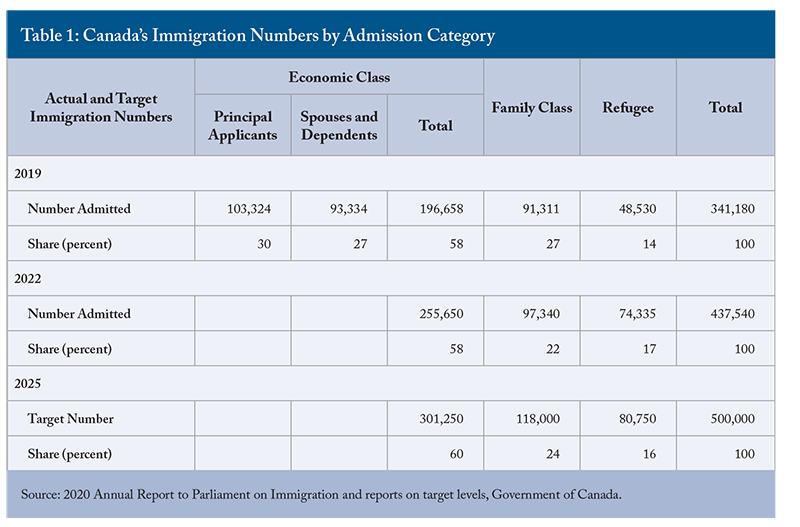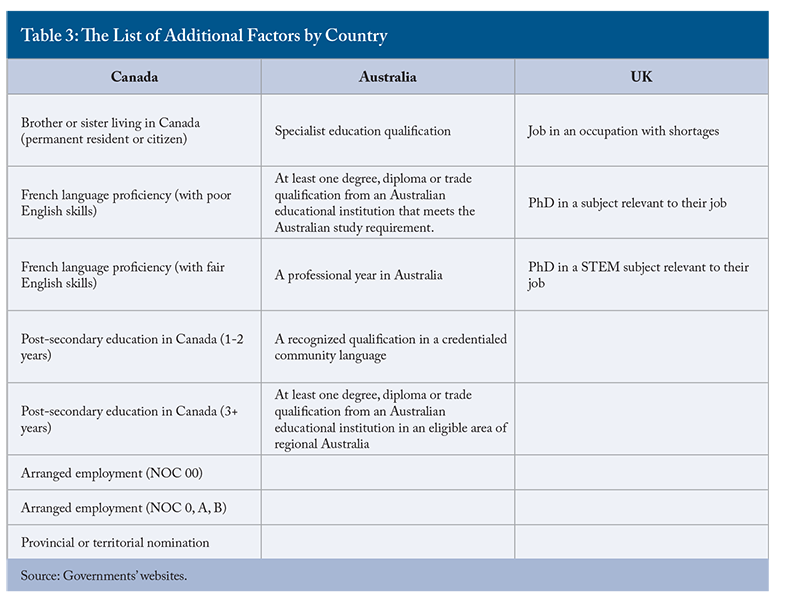The Study in Brief
- Canada’s immigration point system is designed to select skilled immigrants who have the potential to contribute to the country’s economic growth and meet its evolving skills needs. However, Canada faces challenges in fully leveraging increased immigration levels to enhance the well-being of Canadians due to weaknesses in capital investment and a quantity/quality trade-off in selecting economic immigrants. Furthermore, recent reforms may work at cross purposes to this goal. They include category-based selection that targets low-paying occupations, which can discourage capital investment, and a recent surge in the number of temporary residents in low-wage jobs that also may have adverse effects on the quality of potential candidates for permanent residency.
- This study compares skilled immigration selection policy in Canada, Australia, New Zealand, and the UK, with the objective of identifying key areas for improvement in Canadian policy. The skilled immigration point systems in Canada and Australia share some similarities, with both prioritizing a two-step immigration process, placing an emphasis on English proficiency and workforce age, and requiring pre-migration credential and English proficiency assessments. However, the two countries differ mainly in their strictness of criteria and their emphasis on occupational and language skills. Furthermore, Australia has shown more agility and creativity in its skilled migration reforms. Reforms in the UK and New Zealand have also put them ahead in the competition for talent.
- Based on this international comparison, the author makes recommendations for improvement. They include: 1) Setting a Minimum Points Threshold for Eligibility. As it is, Canada imposes no minimum points threshold for eligibility in its Express Entry points-based system. 2) Considering a Pre-admission Earnings Factor. Studies show the importance of pre-immigration earnings in predicting immigrants’ outcomes after arrival. The UK, New Zealand and Australia include this factor. 3) Boosting Standards under the Language Requirement. Official language skills are as important in predicting the initial earnings of principal applicants admitted under Canada’s Express Entry system as pre-immigration Canadian work experience, and even more important than educational level and age at the time of immigration. 4) Raising Business Immigration Numbers. Canada faces the challenge of weak business investment but is failing to select business immigrants with entrepreneurial skills, putting it at a disadvantage compared to competitors like Australia and the UK.
The author thanks Tingting Zhang, Charles DeLand, Rosalie Wyonch, Charles Beach, Jodi Kasten, Mikal Skuterud and anonymous reviewers for comments on an earlier draft. The author retains responsibility for any errors and the views expressed.
Introduction
Economic immigrants bring with them talent, experience, innovation, and financial investments, which all contribute to our economy and address labour market needs. Prioritizing economic immigration, the federal government plans to welcome a record 500,000 newcomers per year by 2025 and maintain that level afterwards. With these targets, the government is seeking to spur economic growth and address labour shortages caused by an aging population.
Canada’s economic immigration system – devised in 1967 as the world’s first points-based system – is designed primarily to enhance the economic prosperity of its citizens. The advantage of this model is that it allows Canada to select for economically productive skills in its intake of immigrants, bringing in the “best and the brightest.” To do so, Canada currently uses an Express Entry system to rank and select candidates for economic immigration. Selection is determined by an assessment of human capital factors calibrated toward the achievement of certain immigration objectives, such as increasing Gross Domestic Product (GDP) per capita – an important metric reflecting the well-being of Canadians.
Views on the effectiveness of focusing on economic immigration to achieve desirable outcomes with high immigration levels have changed over time. Beach, Green, and Worswick (2011) argue that, although increasing the total immigration level lowers the average skill level of new immigrants in the aggregate, increasing the proportion of economic immigrants actually raises the average skill level of immigrants. However, Doyle, Skuterud, and Worswick (2023) argue that, despite Canada’s system succeeding in attracting highly skilled immigrants, it has limitations in its ability to leverage elevated immigration to boost GDP per capita. Specifically, the authors highlight Canada’s weak capital investment and a quantity/quality trade-off in economic immigrant selection. Robson and Bafale (2023) also argue that high immigration is pushing Canada into a path of low productivity and low wages due to insufficient capital investment. This is because some employers choose to rely on a low-wage workforce instead of investing in advanced technologies to improve productivity. Additionally, the point system may not effectively identify immigrants with valuable soft skills such as social and communication competencies, which are increasingly important in today’s labour market.
Strengthening Canada’s Express Entry system to select individuals with high levels of human capital, who are able to integrate into the Canadian labour force most effectively, is essential for maximizing the economic benefits of immigration. However, there is a global race for such talent. An analysis of international competition in recruitment – what other countries are doing and how Canada can best position itself – is necessary to ensure Canada’s talent competitiveness and economic prosperity. This study does a comparative analysis of skilled immigration selection policies in Canada, Australia, New Zealand, and the UK, with the objective of identifying key areas for improvement in Canadian policy.
Furthermore, the government should make better use of data by conducting regular statistical earnings regressions to investigate the optimal criteria and weights for determining immigrant success. By examining the relationship between immigrants’ human capital characteristics at the time of application, and their earnings after landing, we can gain valuable insight into what factors are most important for success. This information can be used to improve immigration selection and ensure that newcomers are set up for long-term success in Canada.
Alongside the importance of a highly skilled immigrant pool, it is critical for Canada to boost living standards by attracting more investors, entrepreneurs, and self-employed individuals who can ameliorate the challenges of job creation and weak investment.
An Overview of the Immigration System in Canada
Canada’s immigration system is a multifaceted framework designed to welcome immigrants under three main categories: economic class, family class, and refugee and humanitarian class. The economic class primarily targets skilled workers, aiming to support the country’s high living standards and bolster its workforce. The family class allows Canadian citizens and permanent residents to sponsor their family members for immigration to Canada. The refugees/humanitarian class is designed to address humanitarian concerns and provide assistance to those in need, such as refugees and individuals facing dire circumstances. Table 1 shows that the economic class is the largest category, representing 60 percent of newcomers. It is important to note that only about half of the category are principal applicants (PAs). It is these principal applicants that are selected based on human capital metrics. Therefore, improvements to Canada’s selection policy would only apply to about 30 percent of all new immigrants. However, since the human capital characteristics of principal applicants and their dependents are correlated (Picot, Hou, and Qiu 2014; Bonikowska, and Hou 2017), improving the selection of PAs is also expected to improve the labour market outcomes of their dependents.
Canada currently offers multiple pathways for immigration under the economic class, including skilled worker programs, the Provincial Nominee Program (PNP), and Business Immigration programs.
There are three skilled worker programs, all of which use Express Entry (EE) for the management of applications. These are the Federal Skilled Worker Program (FSWP), the Federal Skilled Trades Program (FSTP), and the Canadian Experience Class (CEC).
Canada recently introduced a category-based selection under the EE system to target applicants with particular attributes, placing a strong emphasis on qualifications and work experience in specific fields. The system aims to align the immigration process with the country’s evolving needs by prioritizing candidates with specific key attributes. Under this category-based selection system, prospective immigrants are currently evaluated based on two primary criteria: French language proficiency and work experience in targeted occupations, these being healthcare, science, technology, engineering, and mathematics (STEM), trades, transport, agriculture, and agri-food.
PNP is another key channel for economic immigration, allowing provinces and territories to select immigrants who match their local labour market needs.
Business immigration programs provide entrepreneurs, investors, and self-employed persons with opportunities to gain Canadian permanent residency. These programs encompass the Federal Start-up business class, Federal Self-Employed Persons Program, and offerings specific to Quebec and other provinces.
Besides these three main pathways, the economic immigration system also includes specialized programs such as Caregiver classes, the Atlantic Immigration Program for employers seeking foreign talent, additional federal skilled worker programs, and options for those moving to Canada from the United States.
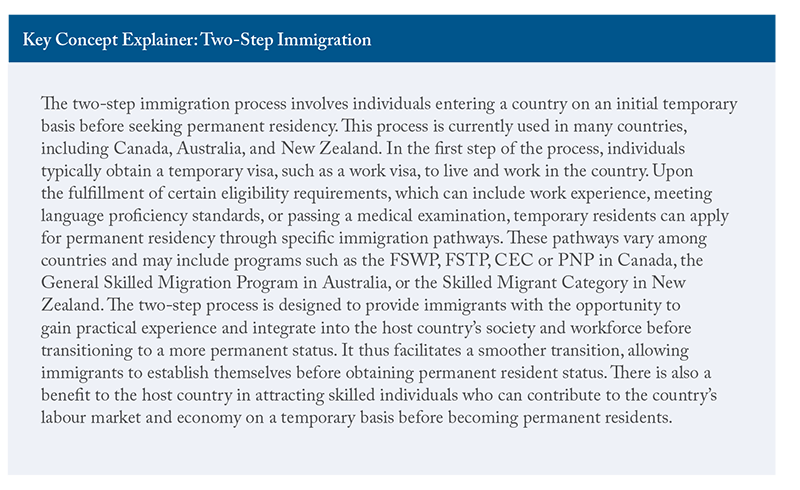
These programs offer different pathways for individuals with diverse backgrounds and aspirations, reflecting the country’s commitment to talent attraction and cultural diversity.
An International Comparison of Points Systems
A points-based immigration system ensures transparency and fairness by assessing candidates according to factors like age, education, language proficiency, and skills. It is a versatile and effective approach to immigration management, promoting economic growth through the selection of skilled immigrants. The system also exercises control over the quality and scale of immigration through a minimum score requirement,
In addition to Canada, several other major immigrant-receiving countries, such as Australia, New Zealand and – more recently – the UK, have implemented points-based systems to prioritize skilled immigration. Variations in selection policies among these nations have an effect on their ability to select top talent, and lead to different economic outcomes for immigrants after their arrival.
Australia and Canada, in particular, have been competing and collaborating with similar policies. While Canada was a leader in the 1960s and 1970s by introducing multiculturalism and human capital selection systems, Australia
Australia and Canada have often seen similar patterns in skilled migrant intake due to similar demographic factors, retention policies, and skill-based selection criteria. However, differences in selection policies, especially in regard to the timing of skilled migration reforms, have led to significant disparities in labour-market outcomes for immigrants in the two countries.
For example, both Canada and Australia have operated points-based selection systems for skilled immigrants, which consider factors such as age, education, work experience, knowledge of languages, and adaptability. But the 1990s saw significant divergence between the two. Canada maintained the original human capital model, admitting individuals with limited language abilities and non-recognized qualifications.
The evidence shows that Australia’s immigration policy reforms resulted in better skills proficiency and labour market outcomes, and more successful labour market integration, in comparison to Canada (Hawthorne 2008; Clarke and Skuterud 2013; Clarke, Ferrer, and Skuterud 2019; Mahboubi 2017; Harrap et al. 2022). The earnings gaps between skilled principal applicants and non-immigrants in Canada were also notably higher than that in Australia. While Australia maintained consistent income patterns among migrants who arrived between 2001-2008 and 2009-2016, Canada experienced worsening income outcomes for the more recent arrivals (2009-2016).
Canada has made major developments and policy changes to catch up with Australia in certain aspects of skilled immigration and to improve the earnings of immigrants. For example, it took a more demand-driven approach to immigration and implemented the Express Entry system in 2015, replacing the first-come, first-served feature of the original points system with a points-ranking system.
Furthermore, it is noteworthy that the UK and New Zealand, like Canada and Australia, have also implemented fast-track points-based immigration systems that give priority to employability. Moreover, the UK and New Zealand take earnings into account as a selection factor to enhance their point systems and integration of immigrants in the labour market, which is supported by data and evidence.
Table 2 compares the current selection criteria and maximum points associated with each factor under EE in Canada with those in Australia, the UK, and New Zealand.
To apply for EE in Canada, candidates must meet all the minimum requirements of one of the Federal Express Entry programs (CEC, FSTP, or FSWP). Eligibility for the FSWP also requires a score of at least 67 out of 100 based on points assigned to six key selection factors.
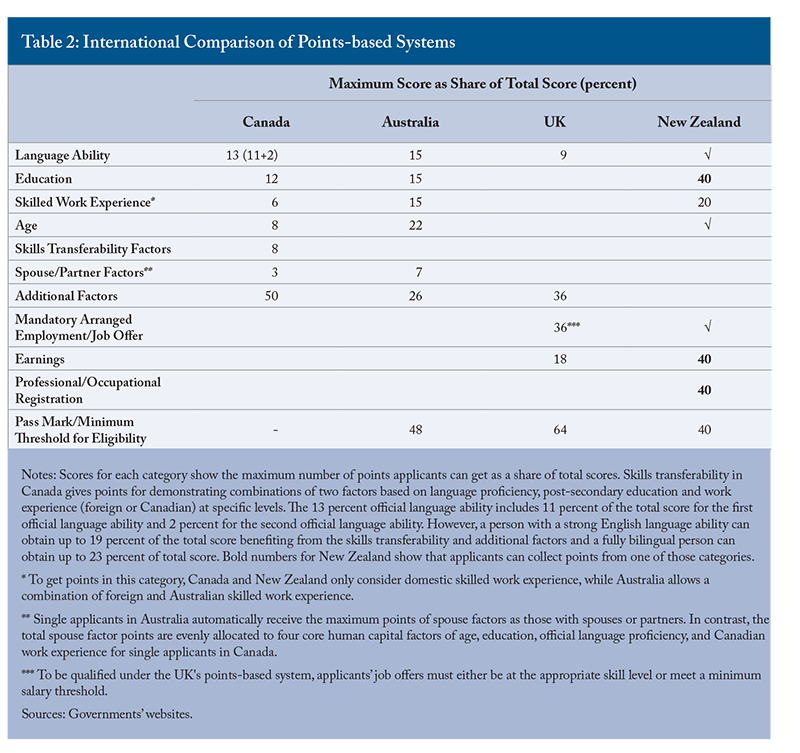
Canada’s EE uses a CRS (comprehensive ranking system) to assess and select candidates, assigning a score for various factors such as age, education, language ability, work experience, and other factors. The maximum CRS score is 1,200. Up to 500 points are available for core human capital factors, 100 points for skill transferability factors, and 600 points for additional factors such as provincial or territorial nomination, job offer, second language ability, and study experience in Canada.
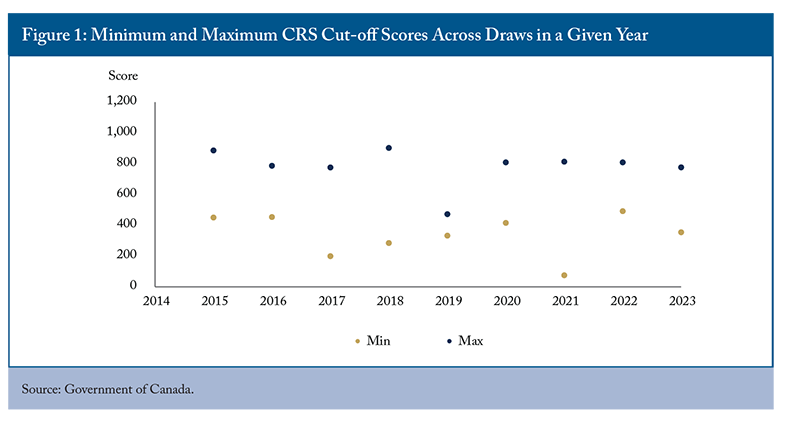
The score for provincial or territorial nomination alone is 600 points, highlighting the important role of provinces in immigration selection. Without a nomination, a candidate can score up to 200 points from a job offer. For candidates with a spouse or common-law partner, the maximum score for core human capital factors of applicants is 560, with 40 additional points available for the spouse or partner’s human capital factors (see Tables A1, A2 and A3). The higher the candidate’s score, the better their chances of receiving an invitation to apply for permanent residency in Canada. Unlike other countries listed in Table 2, Canada has no minimum score requirement for eligibility in its EE system. The cut-off score for selection varies significantly across individual draws, and mainly depends on the number of candidates Canada intends to invite, along with the specific targeted category. For example, it has previously been as low as 75 points (only 6 percent of the total score) to meet the 2021 immigration target level, and as high as 886 (74 percent of the total score) in 2015 (Figure 1). Unfortunately, Canada has been steadily reducing its cut-off score to meet high immigration target levels and address labour shortages, including those in low-wage occupations. This approach potentially undermines the objectives of Canada’s points-based system.
Comparing Canada’s points-based immigration system with other countries shows a resemblance to several aspects of the Australian system, and a marked difference to the UK and New Zealand systems (Table 2).
The Australian immigration point system is a comprehensive framework that assesses candidates based on various factors. Points are allocated for factors like age, educational level, relevant skilled-work experience, and English proficiency (Table 2). To obtain the same score as single applicants with similar human capital characteristics, partners of non-single applicants seeking to migrate alongside the primary applicant need to have competent English skills and a skilled occupation.
Applicants can earn extra points through factors such as having studied in Australia, finishing a post-secondary program in specific Australian regions, completing a recognized professional year in certain occupations, or gaining one year of relevant skilled work experience in Australia (see Table 3). To be eligible for permanent residency, candidates must achieve a minimum 48 percent of the total score (65 out of 135 points), but having more points increases the likelihood of being selected. It is important to note that Australian states hold more authority through the state sponsorship program, allowing applicants to secure permanent residency with 50 points and an additional 15 points for having a state invitation.
While it appears the point systems in Canada and Australia share some similarities, with both prioritizing a two-step immigration process, they are not identical. The main differences between the current Canadian EE system and the Australian system lie in the weights assigned to, and within, factors. For example, up to 67 percent of maximum scores in Australia are directly related to core human capital factors collectively (excluding those under additional factors). In comparison, Canada only assigns 47 percent of the maximum score to human capital factors, including skills-transferability factors.
Comparing the point systems also shows that Australia places a higher emphasis on Australian education, whereas the Canadian immigration system prioritizes Canadian work experience and job offers.
With regard to within-factor variations between Canada and Australia, language ability, in particular, stands out. Australia’s system mainly targets those with superior language skills by excluding candidates with language skills below competency, and giving no points for candidates with competent language skills even though they are eligible to collect points from other factors to apply for immigration (Table 4).
In January 2021, the UK introduced a points-based immigration system, marking a significant change in its approach to immigration. This system treats skilled candidates from both EU and non-EU nations equally. Skilled workers require a mandatory English proficiency at A-level or equivalent, and a job offer. The job must meet two key criteria: it must be at the appropriate skill level and it must meet a minimum salary threshold. This can either be the general threshold of £25,600, or the occupation-specific salary requirement. In lieu of a minimum salary, however, applicants can use points earned for specific qualifications to reach the required points. For example, if a job offer falls below the minimum salary, but is at least £20,480, eligibility may still be possible if the job offer is for an occupation with labour shortages or requires a PhD, especially in STEM. In this case, no points may be obtained from the minimum salary, but from these other factors (see Table 3 for the list of additional factors). This system aims to streamline immigration while ensuring candidates make meaningful contributions to the UK’s workforce and society.
New Zealand introduced a point system in 1991. The system has evolved over time to align with the latest findings and best practices, focusing on employability, two-step immigration, and demographic growth. Starting October 9, 2023, New Zealand made a significant reform, introducing a new points system for the Skilled Migrant Category Resident Visa, to simplify and expedite the application process for highly skilled immigrants. The main changes include a new 6-point requirement for visa applications.
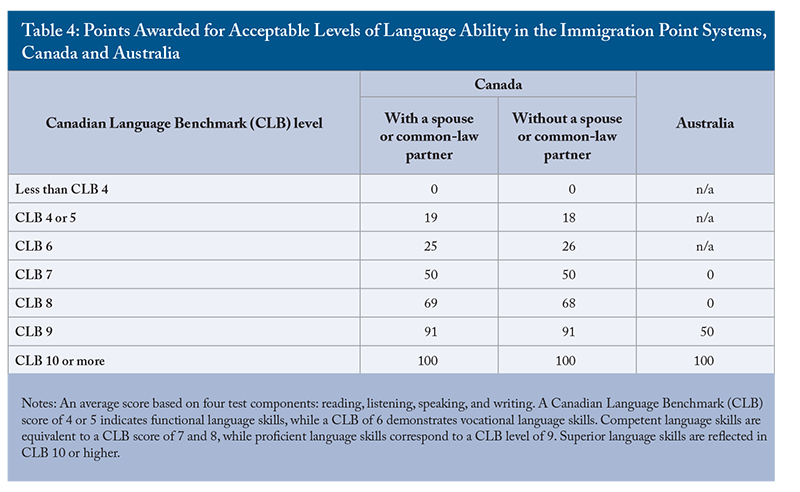
Points are attainable through factors like occupational registration, educational qualifications, and securing an income exceeding the median wage for skilled occupations or 1.5 times the median wage for other occupations in New Zealand.
Naturally, higher wages earn more points. Additional points can be obtained from work experience, to a maximum of 3 points. Applicants must have a skilled job or job offer with an authorized employer in New Zealand and meet specific criteria regarding working hours, occupation level, and wage. Other requirements, such as English language and age limits (55 years or under), remain unchanged. Additionally, New Zealand sets no limit on the number of admissions with the processing time typically within 6 to 8 weeks.
Immigrants’ Economic Outcomes and Contributing Factors
Canada’s immigration points-based system has been gradually influenced and adjusted based on the outcomes of immigrants, the best predictors of immigrant earnings, the evolving needs of the country, and successful policy reforms in other countries.
This section evaluates the earnings outcomes of immigrants in Canada. This is a crucial indicator of their contribution to the country’s economy and will help identify factors for improving the EE.
Historically, Canada has witnessed earnings gaps for new immigrants compared to Canadian-born citizens, which widened in the early 2000s due to increased competition for jobs among highly educated immigrants and Canadian-born workers. The dot-com crash,
However, the late 2010s saw an improvement in the relative earnings of immigrants, which can be attributed to increased labour demand, favourable economic conditions, and a higher tendency to select permanent residency candidates with pre-admission Canadian work experience and education (Crossman, Hou, and Picot 2021). The introduction of Express Entry in 2015, in response to labour market needs, also played a significant role in this improvement.
The labour market outcomes of immigrants greatly depend on the program through which they enter the country. While most new immigrants across all categories struggle in the labour market immediately after their arrival, including spouses under the economic class, principal economic applicants earn significantly more than other immigrants (Figure 2). This is because only the principal applicants in the economic category must meet selection criteria based on factors such as education, language, age, and work experience: criteria that are predictive of success. However, there are variations across economic immigrant categories (Figure 3).
Historically, the median employment income of CEC and PNP principal applicants has been higher than other groups. Except for PNP immigrants, including spouses and dependents, there has been a notable gain in the median employment income of all categories of economic immigrants, especially among skilled worker and skilled trades PAs since the introduction of EE in 2015. One explanation could be that not all PNP immigrants were selected through EE. Although to the best of my knowledge there are no public use data available to accurately identify the share of EE PNP immigrants, my estimates – based on the 2022 admission figures and the EE draws for the PNP – suggest that the majority of PNP immigrants are selected outside the EE system. Picot, Crossman and Hou (2023) identify that, even among the EE system’s principal applicants, human capital levels were higher for FSWP and CEC immigrants than for PNP immigrants. It appears that some applicants who do not meet the requirements for the federal skilled worker programs may opt for the PNP as an alternative route to permanent residency. The implication of these findings is that federal and provincial governments must revisit the eligibility criteria and points allocation (600 points for provincial or territorial nomination factor) as well as the selection process under both PNP streams. Given the significant share of PNP in economic immigration outside of Quebec (41 percent in 2022), Canada should consider processing all PNP applications through the EE.
Notably, key predictors of earnings include pre-landing Canadian work experience,
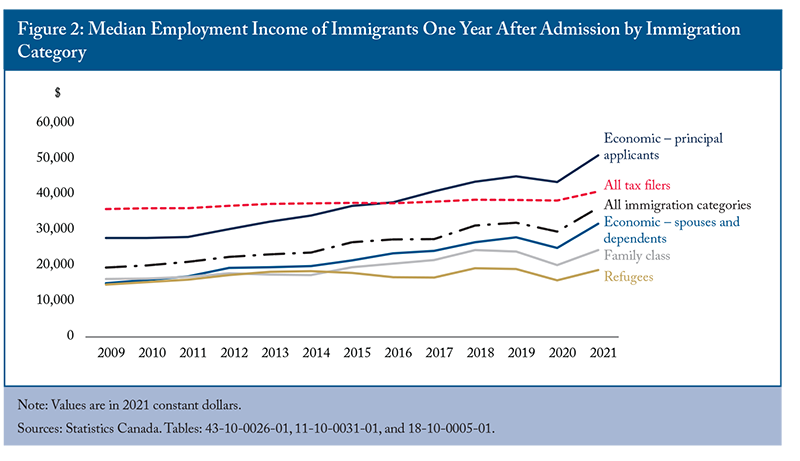
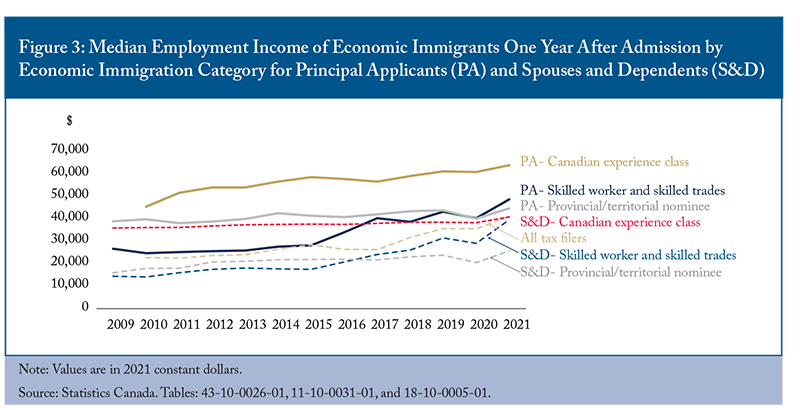
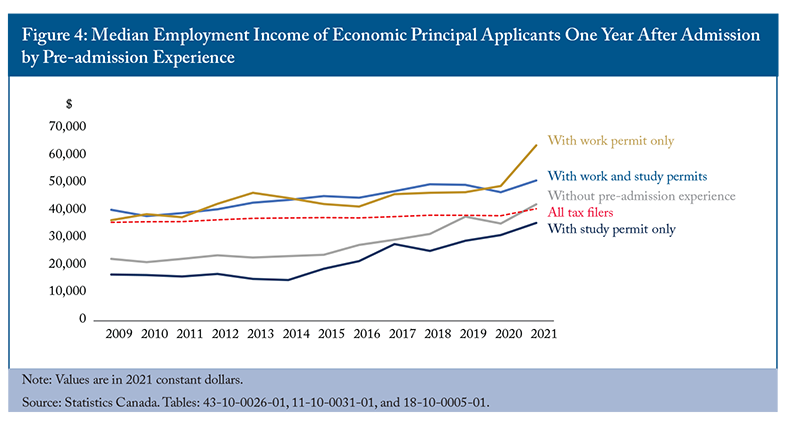
They argue that this performance gap is attributable to two primary reasons. First, the two-step approach involves multiple selection processes that align immigrant skills better with labour market demands, as employers can directly assess workers’ abilities, mitigating challenges faced by one-step immigrants. Second, the advantage gained by two-step immigrants consists of acquiring a head start in Canadian work experience, significantly surpassing one-step immigrants. This prior landing experience strongly predicts immigrants’ earnings, explaining the performance disparity between the two groups. Interestingly, those holding a study permit only do poorly and even fall below those with no pre-admission experience in terms of median employment income.
Hou, Crossman, and Picot (2020) also highlight the importance of high-skilled pre-immigration Canadian work experience, among economic immigrants under the CEC program, for superior post-immigration labour market outcomes. However, having high levels of pre-migration earnings matters more and plays a key role in explaining the differences in labour market outcomes (Hou and Lu 2017; Hou, Crossman, and Picot 2020).
Hou, Crossman, and Picot show that between 2009 and 2016, economic principal applicants selected through CEC and PNP had higher earnings than those selected through FSWP in the first and fifth years after immigration. This is primarily due to a higher proportion of PNP and CEC immigrants having pre-immigration Canadian earnings. However, when accounting for pre-immigration Canadian earnings, CEC and FSWP immigrants had similar earnings five years after immigration. Nonetheless, PNP immigrants had lower earnings than FSWP immigrants, possibly because PNP immigrants were more likely to be selected for lower-skilled jobs.
Furthermore, Xu and Hou (2023) reveal that proficiency in official languages is a significant factor in the EE system and has a substantial impact on earnings. They found that language skills had a similar influence on economic principal applicants admitted through the EE system, regardless of the specific immigration program through which they entered. Bonikowska, Hou, and Picot (2015) also argue that immigrants with strong official language skills benefit more from higher education.
While education is a key contributor to immigrants’ success in the labour market, there are significant disparities in earnings and employment outcomes of skilled immigrants compared to their non-immigrant counterparts. Li (2017) shows that the earnings of foreign-educated immigrants greatly depend on where they obtained their education. Even among highly educated immigrants, the outcomes vary by the country where they obtained the highest level of education. Picot and Hou (2019) show a better outcome among immigrants with doctoral degrees, especially those who obtained their highest education in countries like Canada, the United States, the United Kingdom, and France. These findings suggest that both quality of education, and the level of educational attainment, are critical factors in determining immigrants’ prospects.
Meanwhile, Skuterud and Chen (2018) show that immigrants who were former international students (FIS) at Canadian educational institutions earn significantly more than foreign-educated immigrants with a post-secondary education. However, they warn of a deterioration in FIS outcomes over time. This is likely due to a lack of requirements placed on the type of post-graduation employment, and a trade-off between quality and quantity – particularly as post-secondary institutions and governments have expanded their intake of international students to meet educational and immigration demands. Similar deterioration in earnings outcomes may also occur among those with pre-admission Canadian work experience (e.g., CEC immigrants), due to a potential decline in the quality of temporary residents. There has been a significant increase in the number of temporary workers in Canada to meet employers’ labour demand, notably those in low-wage occupations post-pandemic.
This shift in temporary immigration runs parallel to the introduction of category-based selection in permanent immigration, and the reduction of CRS cut-off scores aimed at reaching immigration targets. These changes could negatively impact the earnings outcomes of economic immigrants in the near future.
In general, the review of research on immigrant outcomes highlights the importance of the Express Entry system in immigrant selection. But it also points to the limitations in predicting post-immigration earnings accurately. In particular, the Express Entry system’s immigration selection factors collectively explain only 15 percent of the variation in post-immigration earnings, with that declining over time (Picot et al. 2022). This weakness suggests the need for enhancing selection criteria by considering effective reforms.
Self-Employment Outcomes of Economic Immigrants
In addition to skilled workers, Canada selects individuals with entrepreneurial skills, business acumen, or experience in managing and owning businesses, through the Business Immigration Program under the economic class.
However, Table A3 shows that Canada is at a significant disadvantage comparatively in the global competition for business immigrants: it welcomed a very low number of business immigrants in 2022 (1,364 business immigrants). A contributing factor is the limited target level for the Business Immigration Program, both in absolute terms and relative to the economic immigration level. The 2022 planned admission range fell between 800 and 1,500, while Australia’s immigration planning level for business innovation and investment was 5,000, and the UK welcomed more than 7,000 investors and business developers.
Another factor can be the often stringent requirements for business immigration. Wang and Hii (2019) argue that business immigration pathways in Canada may deter potential immigrants with high entry barriers and less attractive terms, compared to competing countries like the US, Australia, and the UK. These countries have lower threshold requirements for investors, shorter investment terms, and issue provisional visas with potential extensions based on the fulfillment of immigration conditions.
In addition, understanding and navigating the complex legal and regulatory requirements to establish and run a business in Canada can be daunting for newcomers, especially if they are not familiar with Canadian business practices and regulations. Figure 5 underscores the likelihood of this since only around 24 percent of business immigrant tax filers in 2021 had self-employment income one year after admission. The pre-pandemic incidence of self-employment income among business immigrants
In general, immigrant business ownership rates in Canada often exceed those of native-born citizens, particularly among groups like refugees and family-class immigrants. Reasons for this include challenges in finding regular employment, immigration policies, and support from immigrant networks. Also, immigrants tend to exhibit a greater propensity for risk-taking than non-immigrants (Vandor 2021).
Comparisons between immigrant and Canadian-born business owners reveal several similarities in funding, longevity, and job creation (Picot and Ostrovsky 2021). However, immigrants exhibit slightly higher rates of innovation, largely attributable to a greater percentage of STEM graduates among immigrant business owners. Refugees and family-class immigrants frequently engage in “traditional” immigrant sectors such as transportation and retail, in distinction to economic immigrants and the native-born population. While refugees exhibit a higher tendency to be unincorporated and self-employed, economic immigrants, who typically have higher education levels, tend to own incorporated companies, highlighting a varied spectrum of business ventures among immigrants. However, Green et al. (2023) also find that human capital (e.g., education and Canadian experience) among economic immigrants plays no significant role in the rate of establishment of incorporated firms with employees. The majority of immigrant-owned firms are unincorporated.
Policy Discussion
The Canadian and Australian skilled immigration points systems share some similarities, particularly in the characteristics of immigrants they attract. Both countries have experienced similar trends in the numbers and countries of origin of skilled immigrants.
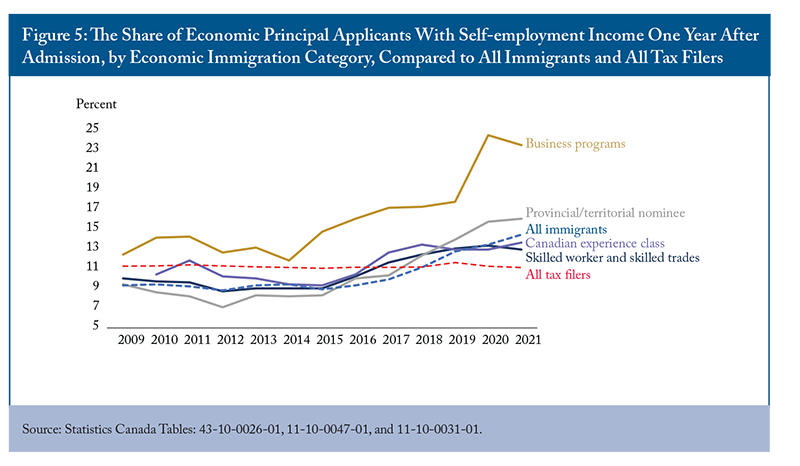
They have successfully attracted immigrants with diverse skills, often favoring a two-step immigration process in which individuals come on a temporary visa and transition to permanent residency. This approach allows them to identify individuals who can contribute effectively to their labour markets and societies.
However, it is important to acknowledge significant differences in the outcomes of immigrants in these two countries. The timing of reforms, the strictness of criteria, and issues with the effectiveness of foreign credential recognition have caused different outcomes between the Canadian and Australian immigration systems (Harrap et al. 2022; Mahboubi 2017). These factors shape the experiences and outcomes of immigrants in each country and underscore the importance of continuous improvement and adaptability in immigration policies.
One notable distinction is in immigrants’ earnings. Skilled immigrants in Canada tend to face lower earnings compared to their native-born counterparts, while in Australia the earnings of skilled immigrants are higher in comparison to native-born residents. These differences can be attributed to various factors, including the timing of reforms, the effectiveness of credential recognition systems, and a greater emphasis on occupational and language skills. For instance, Australia introduced language testing as a requirement in 1999, a decade ahead of Canada. Another important factor is the strictness of the criteria, with Australia’s language proficiency requirements being far stricter than Canada’s.
Although the earnings outcomes of economic immigrants in Canada have increased since the implementation of the Express Entry system, there is still room for improvement. In general, a review of research on immigrant outcomes highlights the importance of the Express Entry system in immigrant selection, but we can also discern its limitations in predicting post-immigration earnings. To a large degree, the EE selection factors are unable to accurately predict post-immigration earnings (Picot et al. 2022). This weakness suggests the need for improving the EE system and enhancing the CRS grids by revisiting selection factors and their associated weights to predict immigrants’ earnings better.
Furthermore, Canada has recently made some reforms under the EE system that could potentially reverse gains. In response to short-term labour market needs, these changes include introducing category-based selection that targets low-paying occupations in the fields of transport, agriculture, and agri-food, for example.
Furthermore, the recent surge in the number of temporary residents may have adverse effects on the quality of potential candidates applying for permanent residence and the selection process, especially with regard to unobserved abilities (e.g., education and experience quality and skills levels), and a disjuncture between labour supply and labour market demands. This could cause a decline in economic performance among more recent immigrants.
In addition to improving the selection process for skilled immigrants, Canada should consider using economic immigration to address its investment needs and raise living standards. With this in mind, several reforms that Canada should consider are:
• Taking an empirical approach to improve Express Entry;
• Setting a minimum CRS points threshold for eligibility;
• Considering a pre-admission earnings factor;
• Boosting standards under the language requirement;
• Raising business immigration numbers while addressing business activity challenges.
Taking an Empirical Approach to Improve Express Entry
Despite the upward trend in economic results for immigrants, the Comprehensive Ranking System (CRS) is unable to predict their labour market success. To improve the CRS and Express Entry selection, the government needs to determine the optimal criteria and weights for selecting skilled immigrants, including Provincial Nominee Program immigrants. The best way to do this is by running statistical earnings regressions that relate immigrants’ post-landing earnings to their human capital characteristics at the time of application. By doing so, the government can identify the human capital characteristics that are most positively correlated with post-landing earnings, and assign higher points and weights to those characteristics.
This approach would ensure that the selection process is based on empirical evidence, and that the most skilled and experienced candidates are selected for immigration. By assigning higher points to the characteristics that are most predictive of post-landing earnings, the government can ensure that immigrants have the best chance of success in Canada.
Setting a Minimum CRS Points Threshold for Eligibility
Unlike all other major immigrant-receiving countries, Canada imposes no minimum points threshold for eligibility in its EE points-based system. The lack of a minimum threshold, while making it easy for Canada to meet immigration target levels, could potentially compromise the quality of skilled immigrants. Canada has previously reduced the cut-off points in order to meet immigration target levels, indicating that the country is willing to prioritize quantity over quality.
Given that Canada is a top destination country for immigration, Canada should be able to meet its economic immigration target levels even as it sets a minimum threshold for eligibility similar to its competitors. Further, the government needs to consider a number of strategies to address the issue:
• Improve the CRS to determine optimal criteria and weights as recommended in this study.
• Select candidates based on their CRS score in a single pool for skilled immigration to bring back predictability and transparency in the system.
• Consider setting immigration targets on a 3- to 5-year basis rather than on a 1-year basis to have greater flexibility to respond to any changes in Canada’s desirability among skilled migrants or unexpected circumstances like COVID-19 that might affect immigrant inflow.
Requiring a minimum points threshold for eligibility under the immigration points system is necessary to ensure the quality of immigrants. Canada has shifted its focus from the human capital model of selection to meeting short-term labour market needs in low-skill occupations. It is time to reverse the tide and catch up with the peers. Setting a minimum threshold for EE could incentivize applicants to improve their scores on factors they can control, such as language ability, to contribute to a more successful integration into the labour market.
Considering a Pre-admission Earnings Factor
As discussed earlier, Canadian studies show the importance of pre-immigration earnings in predicting immigrants’ outcomes after arrival (Hou and Lu 2017; Hou, Crossman, and Picot 2020). The UK and New Zealand have explicitly included this factor in their points-based systems for skilled immigrants, while Australia implicitly accounts for earnings in its point system. There are income thresholds for Australia’s skilled temporary migration system, and a large proportion of permanent skilled immigrants in Australia have previously worked in the country under this type of visa.
There are two advantages to this approach. First, without the ability to accurately assess education and experience quality, pre-immigration earnings can reflect an individual’s labour market skills. Second, by assigning points to an earnings factor alongside Canadian experience, applicants might be incentivized to put more effort into finding employment opportunities that better match their qualifications.
This factor can be included as a core human capital factor and/or a skill transferability factor, similar to the requirement of Canadian experience under the EE. For candidates without pre-admission Canadian work experience, the government can explore the possibility of allocating points for applicants’ earnings based on home country standards, such as a certain threshold of the country of origin’s average earnings in the occupation category, or at the national level.
Boosting Standards under the Language Requirement
Xu and Hou (2023) find that official language skills are as important in predicting the initial earnings of principal applicants admitted under Canada’s Express Entry system as pre-immigration Canadian work experience, and even more important than educational level and age at the time of immigration. This highlights the significance of language proficiency in the Canadian job market, with it playing a crucial role in determining the success of immigrants in the country. Limited language proficiency is a serious barrier to immigrants utilizing their skills in productive employment. However, Canada’s allocation of points is more lenient than that of Australia. To enhance the EE, Canada should consider adopting Australia’s stringent approach for awarding points in language proficiency. This policy change could incentivize applicants to invest in their language abilities before immigration, accelerating the integration process and fostering improved labour market outcomes for both principal applicants and their spouses or partners.
Raising Business Immigration Numbers While Addressing Business Activity Challenges
Canada faces the challenge of weak business investment, but is failing to select business immigrants with entrepreneurial skills, putting it at a disadvantage compared to competitors like Australia and the UK. Attracting and selecting the right immigrant entrepreneurs can contribute to economic growth by leveraging their capital investment, entrepreneurial skills, and innovation.
Ortega and Peri (2014) argue that high immigration levels enhance economic growth, especially through immigrants’ productive skills and innovation. However, this needs to be accompanied by business investment to increase absorptive capacity and productivity in both the labour market and the wider economy. In Canada, only a small share of economic immigrants are business immigrants, despite the need for more capital investment. Furthermore, only a fraction of these immigrants become self-employed, thereby diminishing the potential impact of business immigration on the economy. More needs to be done to encourage business immigration and improve outcomes.
Green et al. (2023) find that, among economic immigrants, only business immigrants had an impact on opening incorporated firms, with their exit rate being high, rendering the program unsuccessful. This suggests that Canada needs to prioritize policies that help business immigrants overcome barriers to investment and start incorporated firms, while selecting for and facilitating the entry of entrepreneurs. Canada should ensure investors and entrepreneurs are able to start and run businesses in Canada. It should take seriously the challenges faced by business immigrants in accessing necessary resources, navigating regulatory frameworks, and establishing sustainable ventures within the country.
Conclusion
Canada’s immigration point system is designed to select immigrants who have the potential to contribute to the country’s economic growth and meet its evolving needs. Earnings outcomes and labour market success, as well as lessons from other immigrant-receiving countries, have been major contributing factors in shaping and fine-tuning this system.
Australia, one of Canada’s major competitors, has demonstrated greater agility and innovation in skilled migration reform by actively leveraging research evidence to develop, oversee, and enhance selection policies. In contrast, Canada’s reforms have often lagged, or lacked stringency.
The primary recommendation of the paper is to enhance the Express Entry system, with a specific focus on refining the Comprehensive Ranking System’s points grid. This improvement will help better identify economic immigrants who are more likely to succeed, in terms of their Canadian labour market earnings. In addition, Canada needs to increase business investment to support immigrants and the existing population. Based on existing research, a comparison of Canada’s point system with its major competitors, and an assessment of immigrants’ performance, this study recommends the following reforms:
- Taking an empirical approach to improve the express entry system;
- Setting a minimum CRS points threshold for eligibility;
- Considering a pre-admission earnings factor;
- Boosting standards under the language requirement;
- Raising business immigration numbers while addressing business activity challenges.
The important contribution immigrants make to the economy depends on the skills, resources and talents they bring with them. Implementing these reforms will enable Canada to compete with its peers in the global search for talent and maximize the economic benefits of immigration.
Appendix
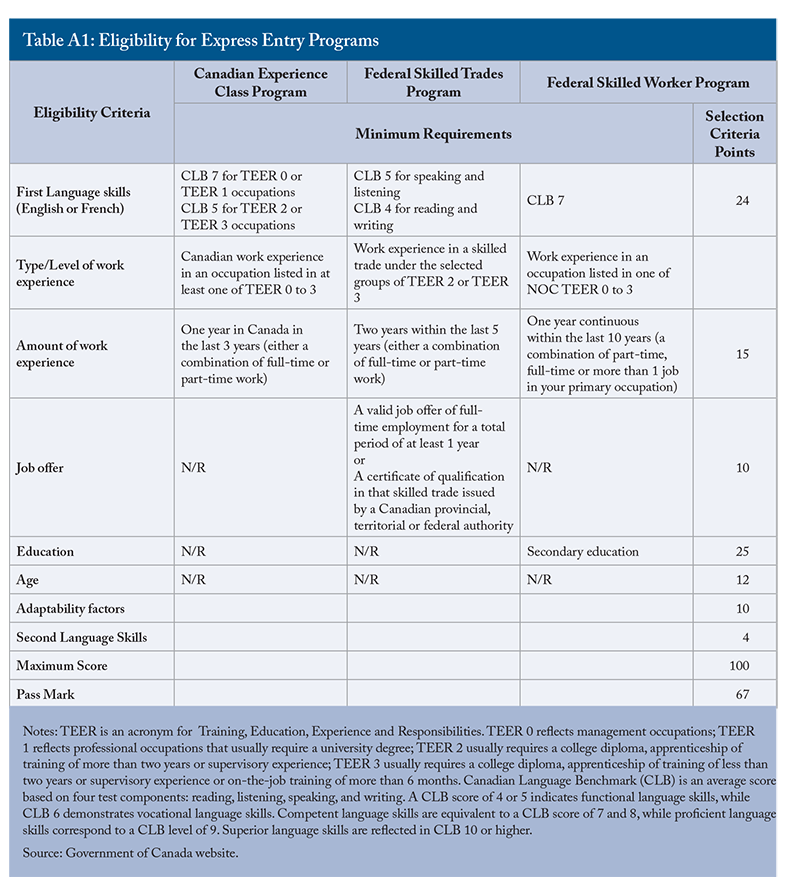
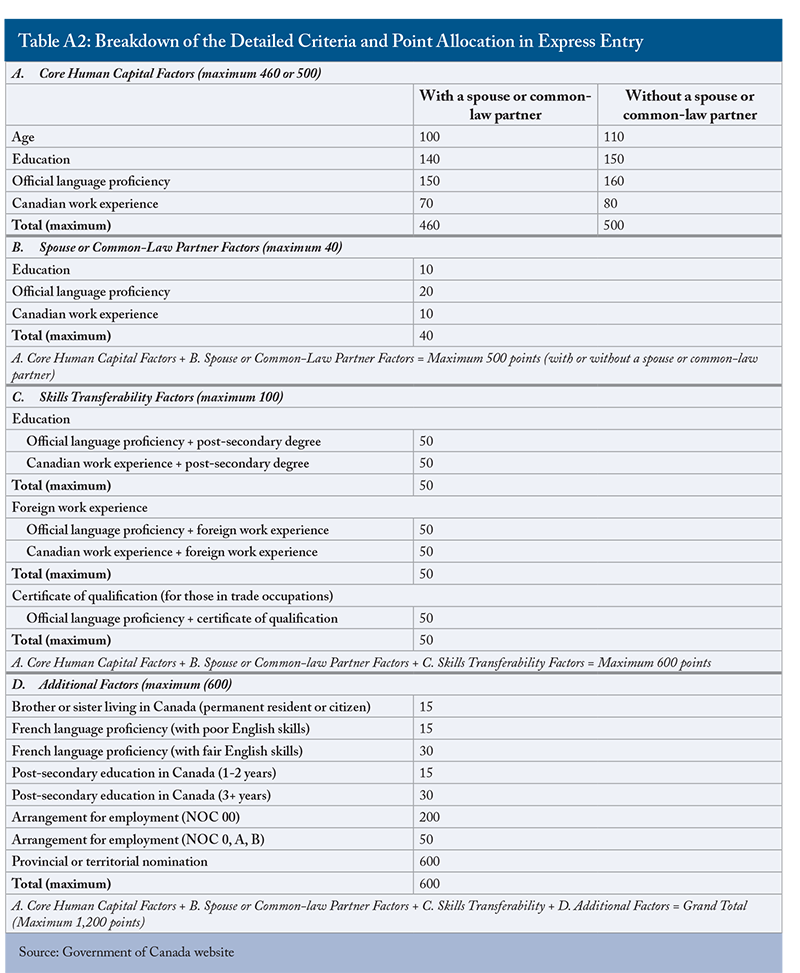
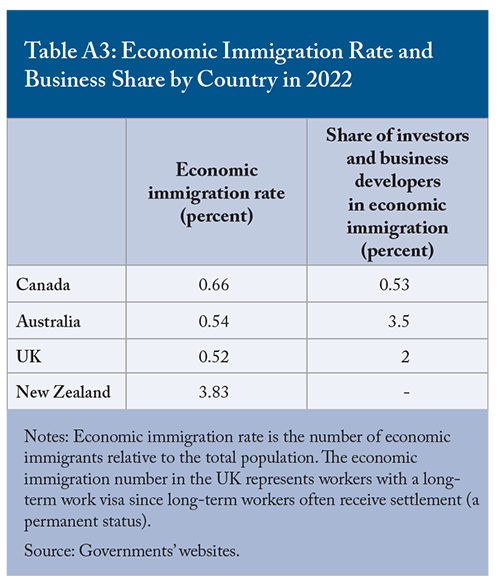
References
Bedford, R., and Spoonley, P. 2014. “Competing for talent: diffusion of an innovation in New Zealand’s immigration policy.” International Migration Review 48(3): 891–911.
Beach, Charles M., Alan G. Green, and Christopher Worswick. 2011. “Towards Improving Canada’s Skilled Immigration Policy: An Evaluation Approach.” Policy Study 45. Toronto: CD Howe Institute,.
Bonikowska, Aneta, Feng Hou, and Garnett Picot. 2015. “Which Human Capital Characteristics Best Predict the Earnings of Economic Immigrants?” Analytical Studies Branch Research Paper Series, Statistics Canada, no. 368.
Bonikowska, Aneta, and Feng Hou. 2017. “Labour Market Outcomes of Immigrant Women who Arrive as Dependants of Economic Immigrant Principal Applicants.” Social Analysis and Modelling Division, Statistics Canada. Catalogue no. 11F0019M – No. 390.
Bonikowska, Aneta, Feng Hou, and Garnett Picot. 2020. “Which Immigration Selection Factors Best Predict the Earnings of Economic Principal Applicants?” Policy Research Branch, Immigration, Refugees, and Citizenship Canada.
Boyd, M. 2014. “Recruiting high skill labour in North America: policies, outcomes and futures.” International Migration 52(3): 40–54.
Clarke, Andrew, and Mikal Skuterud. 2013. “Why Do Immigrant Workers in Australia Perform Better Than Those in Canada? Is It The Immigrants or Their Labour Markets?” Canadian Journal of Economics 46(4): 1431-1462.
Clarke, Andrew, Ana Ferrer, and Mikal Skuterud. 2019. “A Comparative Analysis of the Labor Market Performance of University-Educated Immigrants in Australia, Canada, and the United States: Does Policy Matter?” Journal of Labor Economics 37, Number S2.
Crossman, Eden, Feng Hou, and Garnett Pico. 2021. “Are The Gaps in Labour Market Outcomes Between Immigrants and Their Canadian-Born Counterparts Starting to Close?” Statistics Canada, Economic and Social Reports, Catalogue no. 36-28-0001.
Doyle, Matthew, Mikal Skuterud, and Christopher Worswick. 2023. “The Economics of Canadian Immigration Levels.” CLEF. Working Paper #58.
Hou, Feng, and Garnett Picot. 2024. “Earnings of one-step and two-step economic immigrants: Comparisons from the arrival year.” Statistics Canada, Catalogue no. 36-28-0001.
Green, David, Huju Liu, Yuri Ostrovsky, and Garnett Picot. 2023. “Are Immigrants Particularly Entrepreneurial? Policy Lessons from a Selective Immigration System.” Canadian Labour Economics Forum. Working Paper Series.
Harrap, Benjamin, Lesleyanne Hawthorne, Margaret Holland, James T. McDonald, and Anthony Scott. 2022. “Australia’s superior skilled migration outcomes compared with Canada’s.” International Migration 60(5): 91-107. Available at https://doi.org/10.1111/imig.12940
Hawthorne, L. 2008. “The impact of economic selection policy on labour market outcomes for degree-qualified migrants in Canada and Australia.” IRPP Choices 14(5): 30–38.
Hawthorne, L. 2015. “The impact of skilled migration on foreign qualification recognition reform in Australia.” Canadian Public Policy 41: s173–s187.
Hou, Feng, Eden Crossman, and Garnett Picot. 2020. “Two-step Immigration Selection: An Analysis of its Expansion in Canada.” Economic Insights, Statistics Canada, Catalogue 11-626-X —2020010 – No. 112.
Hou, Feng, and Yuqian Lu. 2017. “International Students, Immigration and Earnings Growth: The Effect of a Pre-immigration Canadian University Education.” Statistics Canada, Catalogue no. 11F0019M – No. 395 ISSN 1205-9153 ISBN 978-0-660-09156-3.
Li, Qing. 2017. “Education Quality and Immigrants’ Success in the Canadian Labour Market.” Toronto: CD Howe Institute.
Mahboubi, Parisa. 2017. The Power of Words: Improving Immigrants’ Literacy Skills. Commentary 486. Toronto: C.D. Howe Institute.
Ortega, Francesc, and Giovanni Peri. 2014. “Openness and income: The roles of trade and migration.” Journal of International Economics 92(2).
Picot, Garnett, Eden Crossman, and Feng Hou. 2023. “Provincial Nominee Program: Recent trends and provincial differences in earnings outcomes.” Statistics Canada, Catalogue no. 36-28-0001.
Picot, Garnett, Feng Hou, Li Xu, and Aneta Bonikowska. 2022. “Immigration Selection Factors and the Earnings of Economic Principal Applicants.” Economic and Social Reports, Statistics Canada, Catalogue no. 36-28-0001.
Picot, Garnett, and Feng Hou. 2019. “Why Do STEM Immigrants Do Better In One Country Than Another?” IZA World of Labour 459: 1-10.
Picot, Garnett, and Yuri Ostrovsky. 2021. “Immigrant Entrepreneurs in Canada: Highlights from Recent Studies.” Statistics Canada. Catalogue no. 36-28-0001.
Picot, Garnett, Feng Hou, and Theresa Qiu. 2014. “The Human Capital Model of Selection and the Long-run Economic Outcomes of Immigrants.” Social Analysis and Modelling Division, Statistics Canada, Catalogue no. 11F0019M — No. 361.
Robson, William B.P., and Mawakina Bafale. 2023. Working Harder for Less: More People but Less Capital Is No Recipe for Prosperity. Commentary 647. Toronto: C.D. Howe Institute.
Skuterud, Mikal, and Zong Jia Chen. 2018. Comparing Outcomes: The Relative Job-Market Performance of Former International Students. Commentary 518. Toronto: C.D. Howe Institute.
Vandor, Peter. 2021. “Are voluntary international migrants self-selected for entrepreneurship? An analysis of entrepreneurial personality traits.” Journal of World Business 56(2).
Wang, Shuguang, and Rebecca Hii. 2019. “Influence of immigration policies on supply of ethnic business entrepreneurs in Canada.” Toronto: Ryerson Centre for Immigration and Settlement.
Xu, Li, and Feng Hou. 2023. “Official language proficiency and immigrant labour market outcomes: Evidence from test-based multidimensional measures of language skills Release.” Statistics Canada, Catalogue no. 36-28-0001 ISSN 2563-8955.


